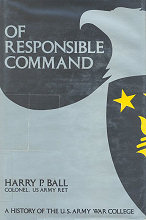
BALL : Of responsible command (fülszöveg)
The purpose was clear. The Army War College was "to study and confer on the great problems of national defense, of military science, and of responsible command." The date was February, 1903; the speaker Elihu Root, Secretary of War to President Theodore Roosevelt.
This book relates how and how well, over eight decades, Root's vision was served. The initial college convened in the fall of 1903. Borrowing from the Prussian military system and from the experiences of the Army's own Artillery School and Infantry and Cavalry School, as well as from the Naval War College, the early institution was a hybrid—both a school and an operational adjunct to the new and controversial War Department General Staff. It performed neither task particularly well.
Begun anew after World War I, separated by statute from the General Staff, the second Army War College was the creation of Secretary of War Newton Baker and Chief of Staff Peyton March but it soon came under the sway of John J. Pershing and his AEF lieutenants. Pershing turned back attempts to broaden the scope and composition of the College; until the early 1930s no widely accepted program emerged. By then disarmament sentiment, the Great Depression, and isolationism washed the Army and its War College into the backwaters of the nation's consciousness. Nonetheless, during this period there passed through the Army War College the men who would organize and lead American armies in global conflict and into the Cold War beyond.
A perhaps worthy but doomed attempt by George Marshall and Dwight Eisenhower to build a joint services educational system delayed reestablishing the Army War College for five years after World War II and robbed it of its physical assets and much of its institutional memory. Reborn concurrently with the Korean War, confronted soon after with President Eisenhower's policy of massive retaliation, the Army War College attempted to provide its members with an intellectual response to that short-sighted strategy. By 1958 it had assumed a perspective more national than military.
In the 1960s an overpowering Office of the Secretary of Defense forced upon a reluctant and resisting institution consideration of scientific methods of management and the less scientific tenets of counterinsurgency. The 1970s added more difficulties. The Vietnam War and the turmoil that accompanied it created almost a crisis of confidence within the officer corps, its very professionalism not infrequently under attack. The War College's response to that crisis may prove to be one of its brighter chapters. That remains to be seen. But what can be clearly seen, in the author's view, is that the Army War College has remained true to Elihu Root's charge, particularly to his admonition to attend to the great problem of responsible command.